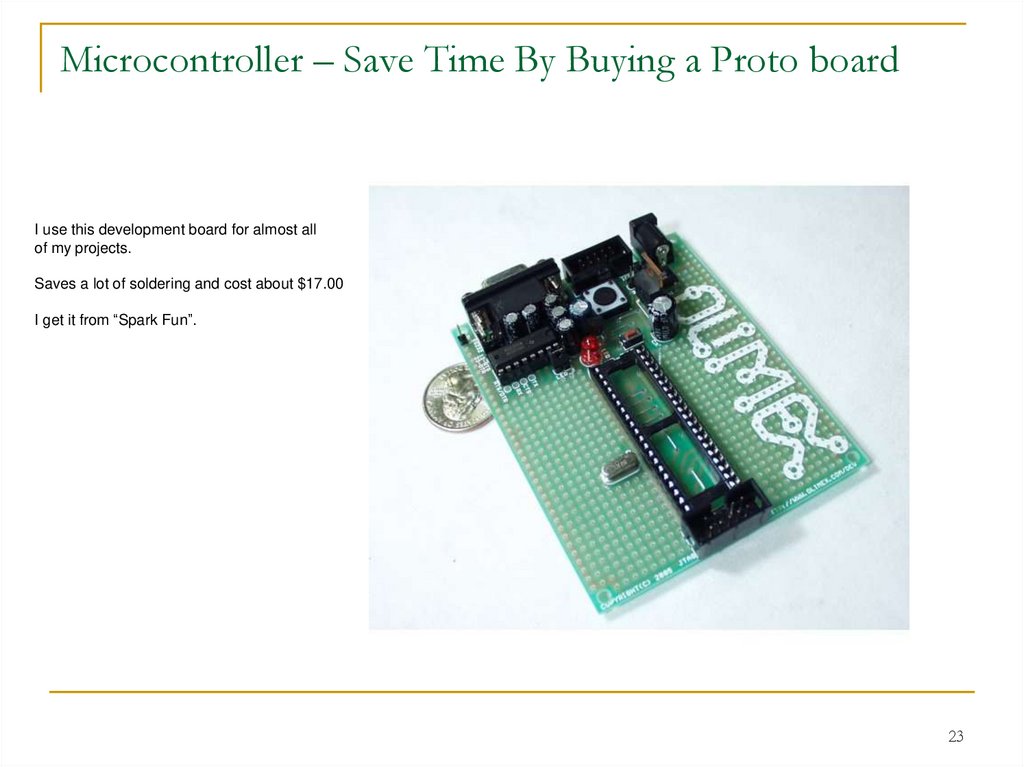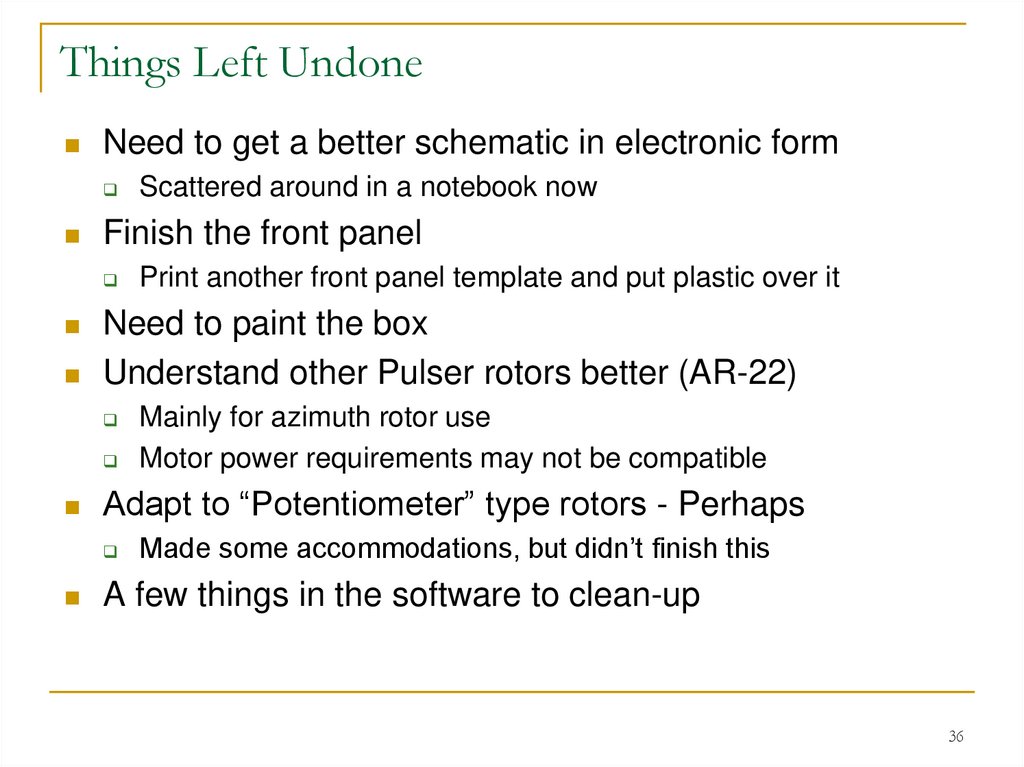Similar presentations:
Using Microcontrollers in Amateur Radio, an AZ EL Controller Application
1. Using Microcontrollers in Amateur Radio, an AZ EL Controller Application
A Presentation For The Southwest Ohio Digital SymposiumPresented by Bill Erwin – N9CX
January 10, 2009
1
2. Things I Hope To Leave You With
Share my experience with the rotor controller projectExplain why I made the choices I did
How it works
Status of the project
But more than that:
Why a microcontroller was a good choice for this project
What software development environments are all about
Tempt you to consider experimenting with microcontrollers
Feel free to ask questions at any time !
2
3. Motivation For This Project
Developed an interest in LEO (Low Earth Orbit) satellitesCommercial rotors & controllers are available
Led to an interest in a better antenna system
Wanted to track LEOs with small beam antennas
Didn’t want to commit that much money at this stage of interest
Decided to use inexpensive rotors & build my own
controller
3
4. Low Earth Orbit Satellites
Basically LEOs are orbital repeatersAMSAT has a lot of information on the WEB
LEOs offer some special challenges
They move fast.
Short contacts
Low RF power
4
5. LEO Satellites Vary In Both Size & Complexity
LEO Satellites Vary In Both Size & ComplexityAO-51 (Echo)
~800 km orbit
voice repeater
PakSat BBS
PSK31 Digital
SuitSat-1 (AO-54)
Russian space suit
Launched from ARISS ~355 km
telemetry only
temp & battery
N-Cube2
10x10x10 CM
I LITER VOLUME
(University Projects)
~690 km orbit
5
6. Satellite QSOs Are Interesting!
There are a lot of “things” involved in working the LEOsatellites!
Computer screen
Keyboard
Mouse
Downlink frequency
Uplink frequency
Doppler effects
Code paddles or a microphone
Azimuth of the satellite
Elevation of the satellite
6
7. So Many things – So Little Time!
The window for a QSO is often less than 8 minutes.If you can automate a few “things”, your QSOs may have
more “talk” time.
This project is about automating the rotors for directional
azimuth & elevation antennas.
7
8. My Approach To The Project
Research the WEB for similar projectsEvaluate what I might do that is different
Understand how rotors work
Keep it (relatively) cheap
Breadboard parts of the design to verify critical
assumptions
Rotor controller needs an LCD display & flashing LEDs!
8
9. Why Use A Microcontroller Anyway?
910. Choices To Make
FeaturesRotors
Software Development tools & Environment
Microcontroller
10
11. Desirable Features
Work with the Nova tracking softwareHave 2 main modes: “manual” & “autotrack”
Self-calibrate to any Pulser type rotor
Remember antenna position during powerdown.
Reliable beam positioning – within 5 degrees.
Easy to update the controller software.
Minimize cost
11
12. The Rotor – You must understand the thing you are trying to control!
The Alliance U10012
13. Yes – You Can Stack Them
The ability to put a pipe throughthe rotor body is fairly unique.
Elevation
Azimuth
13
14. Anatomy Of A U100 Rotor #2
1415. Anatomy Of A U100 Rotor #3
Pulser CamPhysical stop tab
15
16. Anatomy Of A U100 Rotor #4
Pulsing contactMotor shaft Gear
Mechanical Stop
Motor Frame
16
17. Commercial Controller for the U100 Rotor
10 degree graduations on the dial17
18. The Original U100 Rotor Schematic Diagram
RotorControl Box
18
19. Model of the U100 Rotor
Strategy1. Do an initial calibration to detect
rotor’s pulse characteristics.
2. Absolute direction is known at each
pulse & at rotor physical stops.
3. Time between pulses to estimate
position of rotor to a finer degree of
resolution.
4. Time between pulses to detect
rotor limit or problems.
Calibration Mode calculates:
1. deg/pulse = 360 Deg/# pulse (counted)
360/ 0 Deg.
physical stop
2. tics/deg = tics/pulse / deg/pulse
3. Use physical stops as a reference
~ 100 MS
//
//
90
270
+
Total feedback from the rotor
-
Note – A “tic” is 5 milliseconds
180
19
20. Block Diagram Of the Rotor Controller
Front Panel SwitchesFront Panel LEDs
Front Panel LCD
A
T
M
E
G
A
1
6
SS relays and
Phasing capacitors
15 vac
Opto isolator
CW
CCW
Common
AZ Rotor
Pulsing Contact
down
SS relays
Phasing capacitors
15 vac
Opto isolator
up
Common
EL Rotor
Pulsing Contact
5 Volt regulator
MAX 232 chip
Ceramic resonator
Etc.
Support circuitry
Note - This diagram does not indicate pin assignments
20
21. A FEW OF THE ATMEGA 16 FEATURES
THE DATA SHEET IS 358 PAGES !– 32 x 8 General Purpose Working Registers
– Up to 16 MIPS Throughput at 16 MHz
– 16K Bytes of In-System Self-programmable Flash program memory
– 512 Bytes EEPROM
– 1K Byte Internal SRAM
– Two 8-bit Timer/Counters with Prescalers
– One 16-bit Timer/Counter with Prescaler
– Real Time Counter with Separate Oscillator
– Four PWM Channels
– 8-channel, 10-bit ADC
– Byte-oriented Two-wire Serial Interface
– Programmable Serial USART
– Master/Slave SPI Interface
– 32 Programmable I/O Lines
YOU CAN NOT USE ALL AT SAME TIME – SHARE I/O PINS
21
22. Microcontroller – Atmel Atmega16
YOU GET A LOT OF FUNCTIONALITY IN A SINGLE PACKAGE22
23. Microcontroller – Save Time By Buying a Proto board
I use this development board for almost allof my projects.
Saves a lot of soldering and cost about $17.00
I get it from “Spark Fun”.
23
24. Partial Schematic of the Rotor Controller System – Rotor interfaces
Micro Controller's power supply ( +5 vdc)VCC
AZ –CW PA0 (pin1)
AZ –CCW PA0 (pin 2)
X
X
<
JGC-5F
2K
X JGC-5F
Front panel AZ Pulse LED
R1
Solid State Relays
(opto isolated)
\/\/\/\
Current limit resistor
To I/O port pin
|( )|
AZ – PD6 (pin20)
4N25
30 VCT xfmr
rotor
1O
O2
AZ Rotor
U100
3O x
O4
To micro controller common
15 VAC
Rotor common
110 VAC
~20 VDC
)|
R3
470 2W
15 VAC
3
3O X
O4
U100
1O
O22
EL – PD7 (pin21)
EL Rotor
To micro controller common
O
(
<
XJGC-5F
2K
R2
O
|
X
X
4N25
\/\/\/\
JGC-5F
To I/O port pin
x
|( )|
<
Current source for
LCD Backlight
Front panel EL Pulse LED
EL –UP PA2 (38)
EL–DOWN PA3 (pin37)
VCC
24
25. Front Panel Switches – Interface to the Microcontroller
Micro Controller Port assignments (Active low)Port A Pin 0
Port A Pin 1
Port A Pin 2
Port A Pin 3
Port A Pin 4
Port A Pin 5
Port A Pin 6
Port A Pin 7
-
Azimuth ClockWise (CW)
Azimuth Counter ClockWise (CCW)
Elevation Up
Elevation Down
Calibrate momentary pushbutton
Auto Track momentary pushbutton
Azimuth Pulse input
Elevation Pulse input
LCD Port assignments (4 bit data interface)
Details are in a header file
25
26. Development Environment
Fedora Core 7 GNU/LINUXWith AVR-GCC tool chain
Write/debug source code
Program flash memory
using “avrdude” utility
Debug data Serial port
Rotor control cable
Novacomm1 protocol
Windows – running NOVA
26
27. Features On My Rotor Control Box
2X16 BACKLIGHTED LCDON-OFF-ON
N.O. Pushbutton
SPST
N.O. Pushbutton
ON-OFF-ON
Indicates rotor pulse
27
28. Manual Mode - AZ & EL Reading
Manual Mode - AZ & EL Reading28
29. Auto track mode – tracking AO-10 satellite
2930. The Rotor Teststand
3031. A Look Under The Hood
Programming headerXfmr for controller board
Controller Board
Fuse holder
PWR cord connector
Serial in from PC
Serial out for debug
Front Panel
Rotor power
Rotor wires plug
In here.
Phasing caps/SS relay boards
31
32. A Few Software Statistics
ATMEGA 16 ControllerSoftware Sizes
Program 13394 Bytes
Data
262 Bytes – Initialized read only data
BSS
399 Bytes – initialized read/write data
Total
13995 Bytes
30 source files
16KBytes Flash (Program) memory
512 Bytes of EEPROM
1 K SRAM
All source is written in “C”
AVR-GCC Tool Chain programs
32
33. High Level Software Design
BACKGROUND processing every 5 millisecondsWatch every switch in the system
Maintain software timers
Monitor & debounce every switch in the controller
Advertise debounced state to the FOREGROUND processing
Decrement every interrupt (5 ms)
FOREGROUND processing
Manage a simple “state machine” based on operating modes:
Calibrate
Initialize
Manual
Auto
Manages the front panel LCD display & LEDs
Fault detection/recovery strategy
33
34. Field Day 2008 Satellite Antenna Setup
3435. Performance Of The Controller
Used successfully in last two Field DaysSensitive to drag on the beams – coax
False detection of physical stop or obstruction
Dressing the coax better resolved this
Have changed “late pulse” detection parameters
Be sure the beams are oriented properly before raising
the mast <Hi Hi>
I consider it a success but it has not seen extensive use
35
36. Things Left Undone
Need to get a better schematic in electronic formFinish the front panel
Mainly for azimuth rotor use
Motor power requirements may not be compatible
Adapt to “Potentiometer” type rotors - Perhaps
Print another front panel template and put plastic over it
Need to paint the box
Understand other Pulser rotors better (AR-22)
Scattered around in a notebook now
Made some accommodations, but didn’t finish this
A few things in the software to clean-up
36
37. Closing Thoughts About Antenna Rotors
Pulsers have many issues to considerResolution - must interpolate
Calibration process
Must have persistent memory (power-down) for AZ & EL position
Can find them reasonably priced at hamfests
Potentiometer type rotors seem less complicated
Always know where the rotor is
No persistent memory required for power-down
No interpolation required
No directional history needed
Less opportunity to get out of sync.
Nova tracking software may do most of the work for you
But – these rotors may be expensive!
37
38. FROM A SOFTWARE PERSPECTIVE
This was an interesting microcontroller project!Microcontrollers can be used for a lot of amateur radio projects!
If you are patient and persistent you will be successful!
38






































 electronics
electronics








